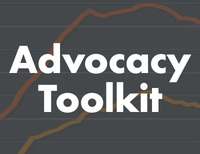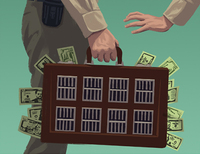Letter accompanying a submission of 'The Prison Index: Taking the Pulse of the Crime Control Industry' to the American Bar Association to inform its review of criminal justice policy.
by Peter Wagner and Brigette Sarabi,
November 3, 2003
The Western Prison Project and the Prison Policy Initiative sent this letter to members of the ABA Justice Kennedy Commission:
November 3, 2003
Dear Member of the ABA Justice Kennedy Commission,
The Western Prison Project and the Prison Policy Initiative were excited to learn that the ABA has answered the challenge issued by Justice Kennedy to examine U.S. incarceration policy. As you know, our nation’s recent reliance on incarceration as a one-size-fits-all solution to social problems has put the world’s foremost democracy into the unenviable position as the world’s leading denier of liberty.
In lieu of submitting formal testimony, we are sending to each member of your commission a copy of our newest report The Prison Index: Taking the Pulse of the Crime Control Industry. The report summarizes state of crime control in the United States, finding that a combination of sentencing policies and economic factors have created a criminal justice system that fails by all possible metrics but one: the creation of more prisoners.
We are heartened by your response to Justice Kennedy’s call to break this morally and economically bankrupt cycle of building more and more prisons to house ever greater numbers of our citizens in ever more deplorable conditions. We hope your forthcoming report will have great influence.
There is precedent for a nation taking the advice of its professional class and transforming its criminal justice policies. Finland used to have a high incarceration rate without a European peer — except for that of the Soviet Union. Coming out of World War II and into the Cold War, that was the last society Finland wanted to resemble. Like the United States, Finnish leaders had become accustomed to high levels of incarceration. Academic exchanges with foreign criminologists put the exceptionalism of the Finnish situation on the policy agenda. Once the highest incarcerator in Western Europe, Finland today incarcerates only 50 of its citizens per 100,000 people, second lowest after Iceland.
We hope that the reexamination of our criminal system you are seeking will lead to a similar transformation. There may not be a simple answer to the question “How low should the prison population be?” But we can clearly say that Finland does quite well with one tenth the incarceration rate of our country.
Sincerely,
Brigette Sarabi
Executive Director
Western Prison Project
Peter Wagner
Assistant Director
Prison Policy Initiative
Article by Peter Wagner explaining that up to three quarters of the crew members fighting California fires are prisoners who are paid up to one dollar per hour.
by Peter Wagner,
October 30, 2003
In California, up to three quarters of the crew members fighting California fires are prisoners. In exchange for a reduction in sentence length, 4,100 minimum security prisoners work fighting fires and on public works projects for a $1 or less an hour.
Prisoners contributed 3.1 million hours fighting fires in California last year, earning only $1 an hour. By contrast, the average forest fire fighter in the U.S. earns $17.19 an hour, or $35,760 a year. Prisoners working on public works projects earn even less, $40 a month.
Using prisoner labor saves the state of California $200 million a year, $80 million in salary and $120 million in employee benefits and security costs. With almost one-third of minimum security prisoners moved from behind razor wire and onto the fire-lines, corrections costs are therefore lower.
The program is not limited just to adult prisoners. Last year the California Youth Authority contributed 684,000 slave-hours to firefighting, saving the state $3.9 million. Of course, it does not appear any of the savings were redirected into college scholarships for previously incarcerated youths.
Prisoners take the jobs because it reduces their sentence, gets them outside, and pays better than the typical prison job. But there are risks. Four years ago a prisoner was killed when he fell 150 feet down a slope fighting a Ventura County fire. The prisoner profiled in the San Diego Union Tribune, Peter Quintana, explained how prisoners are so desperate to earn money or shorten their sentences that they jeopardize their own health working in unsafe conditions for low wages:
“He believes he broke a toe in March while clearing a fire line to slow a blaze near Lakeside. ‘It happens’ he said. ‘It was about 2 or 3 am and we didn’t have much light. I swung my Pulaski (a tool to clear vegetation) and it bounced off a branch and hit my toes.’ Rather than report the injury and risk being dropped from the program, Quintana said he ignored the pain and kept on working.”
Sources:
San Diego Union-Tribune August 12, 2003 and U.S. Department Bureau of Labor Statistics
Article discusses how rural prison expansion contributes to long-standing racial disparities between correctional officers and incarcerated people.
by Peter Wagner and Rose Heyer,
September 25, 2003
Originally published on September 25, 2003 on Alternet
By Peter Wagner and Rose Heyer
In September 1971, thousands of prisoners at Attica prison in rural New York State rebelled, taking control of D-yard. Sixty-three percent of the prisoners were black or Latino, but at that time there were no blacks and only one Latino serving as guards. Seventy percent of the prisoners were urban, mostly from New York City, but 80 percent of the guards were from rural New York.
The disparity between the keepers and the kept increased tensions at the prison by inserting a cultural gulf between guards and prisoners, and by giving black and Latino prisoners painful evidence that their fate was, in part, determined by race.
After four days of negotiations, Governor Rockefeller ordered an assault on the prison, turning what was then the largest prison rebellion into the bloodiest. Thirty-two prisoners and 11 guard hostages died, almost all in the retaking of the prison.
Attica and the investigation into its causes caused a fundamental reexamination of correctional policy throughout America. While food, mail policies and rehabilitative programs were improved, the demand for more black and Latino staff proved to be among the easiest to support and the most difficult to implement. Writing in 1973 about “modern” correctional facilities, leading scholar William Nagel well summarized the response and the dilemma: “To avoid a federal Attica, the Federal Bureau of Prisons is now feverishly attempting to recruit black staff, but its task is complicated by the remoteness of its facilities.”
By 1995, the latest year with complete data, the prisoner population at Attica had increased to 80 percent black and Latino. But out of a total staff of 854, the number of blacks had only risen to 21 and the Latino staff to 7. Attica’s staff remains 96.7 percent white because Attica itself has not moved. It remains in a rural, overwhelmingly white region in New York State.
While prisons themselves are impossible to move, this lesson of Attica about the dangers of prisoner-staff disparities has been lost in the rush of the late 1980s and 1990s to build more prisons. Speculative ideas about rural economic development have trumped safe and rehabilitative correctional policy. Two-thirds of new prisons have been built in rural areas despite the experience at Attica and despite the research showing that incarcerating a prisoner close to home aids family visits and helps reduce the odds a prisoner will re-offend and be returned to prison.
Prior to 1980, 36 percent of prisons were in rural areas, although only 20% of the country is rural. But by the early 1990s the trend was going the wrong way, with 60 percent of new prisons being built in rural areas.
Senior federal officials explained the results to Nagel in 1973: “In the rural areas you get the very best type of white, mid-American line staff; but it is admittedly more difficult to recruit blacks and professional staff which are available in the cities.”
Has the federal Bureau of Prisons or state departments of correction succeeded in overcoming the difficulties in attracting black staff to rural prisons? According to our analysis of prison staffing at each prison operating in 1995, the answer is no.
In 1995, there were 889 federal and state prisons with at least 100 black prisoners. After excluding a handful that did not provide the race of prisoners or staff, we were able to identify only 64 prisons where the percentage of staff that were black was at least as high as the percentage of the prisoners that were black. Of those prisons, not one was outside of the south or the urban cities of the north.
Half of the prison cells in this country are filled with black citizens, but only 20 percent of the prison jobs are held by black employees. In the eyes of the American justice system, it appears every race still has its separate place.
Peter Wagner is a Soros Justice Fellow at the Prison Reform Advocacy Center in Cincinnati, Ohio. Rose Heyer is an independent researcher in Massachusetts.
Johnny Cash consistently identified with the downtrodden and recorded a number of songs about the hopeless misery of imprisonment.
by Peter Wagner,
September 12, 2003
San Quentin, may you rot and burn in hell.
May your walls fall and may I live to tell.
May all the world forget you ever stood.
And the whole world will regret you did no good.
–Johnny Cash, “San Quentin” 1969
In Memory of Johnny Cash
February 26, 1932 – September 12, 2003
September 12, 2003 — The Man in Black, country music star Johnny Cash, died today at age 71. Although Johnny only spent one day in jail himself, he consistently identified with the downtrodden, eagerly performing a number of free concerts for prisoners. Two of these concerts became popular albums Live at San Quentin and Live at Folsom Prison. He was best known for Folsom Prison Blues, about the endless loneliness faced by a reformed man in prison:
I hear the train a-comin’
It’s rollin’ round the bend.
And I ain’t seen the sunshine
Since I don’t know when.
I’m stuck in Folsom Prison
And time keeps draggin’ on.
Johnny wrote or recorded a number of songs about the hopeless misery of imprisonment including Send a picture of Mother, The Wall, The walls of a prison, There ain’t no good chain gang, I got stripes, (I heard that) lonesome whistle, Green, Green Grass of Home, Give my love to Rose, Jacob Green, Austin Prison, Orleans Parish Prison, and a number of songs authored by prisoners present at his performances, including I don’t know where I’m bound.
In memory of the Man in Black, his work, and his music, it seemed appropriate to highlight two of his lesser known songs: “Man in Black” and “San Quentin”.
We’ll miss you Johnny. May all the world never forget you sang. All the world will rejoice you did so much good.
Man In Black
Well, you wonder why I always dress in black,
Why you never see bright colors on my back,
And why does my appearance seem to have a somber tone.
Well, there’s a reason for the things that I have on.
I wear the black for the poor and the beaten down,
Livin’ in the hopeless, hungry side of town,
I wear it for the prisoner who has long paid for his crime,
But is there because he’s a victim of the times.
I wear the black for those who never read,
Or listened to the words that Jesus said,
About the road to happiness through love and charity,
Why, you’d think He’s talking straight to you and me.
Well, we’re doin’ mighty fine, I do suppose,
In our streak of lightnin’ cars and fancy clothes,
But just so we’re reminded of the ones who are held back,
Up front there ought ‘a be a Man In Black.
I wear it for the sick and lonely old,
For the reckless ones whose bad trip left them cold,
I wear the black in mournin’ for the lives that could have been,
Each week we lose a hundred fine young men.
And, I wear it for the thousands who have died,
Believen’ that the Lord was on their side,
I wear it for another hundred thousand who have died,
Believen’ that we all were on their side.
Well, there’s things that never will be right I know,
And things need changin’ everywhere you go,
But ’til we start to make a move to make a few things right,
You’ll never see me wear a suit of white.
Ah, I’d love to wear a rainbow every day,
And tell the world that everything’s OK,
But I’ll try to carry off a little darkness on my back,
‘Till things are brighter, I’m the Man In Black
San Quentin
An’ I was thinkin’ about you guys yesterday. Now, I been here three times before, an’ I think I understand a little bit about how you think about some things, it’s none of my business how you feel about some other things and I don’t give a damn how you feel about some other things! But anyway, I tried to put myself in your place, and I believe this is the way that I would feel about San Quentin.
San Quentin, you’ve been livin’ hell to me.
You’ve galled at me since nineteen sixty three.
I’ve seen ’em come and go and I’ve seen them die,
And long ago I stopped askin’ why.
San Quentin, I hate ev’ry inch of you.
You’ve cut me and you’ve scarred me through an’ through.
And I’ll walk out a wiser, weaker man;
Mr Congressman, why can’t you understand?
San Quentin, what good do you think you do?
Do you think that I’ll be different when you’re through?
You bend my heart and mind and you warp my soul,
Your stone walls turn my blood a little cold.
San Quentin, may you rot and burn in hell.
May your walls fall and may I live to tell.
May all the world forget you ever stood.
And the whole world will regret you did no good.
San Quentin, you’ve been livin’ hell to me.
A series of maps of North Carolina showing incarceration rates and prison expansion over time by county.
by Rose Heyer,
September 1, 2003
These maps were prepared for the National Resource Center on Prisons and Communities, September 2003.
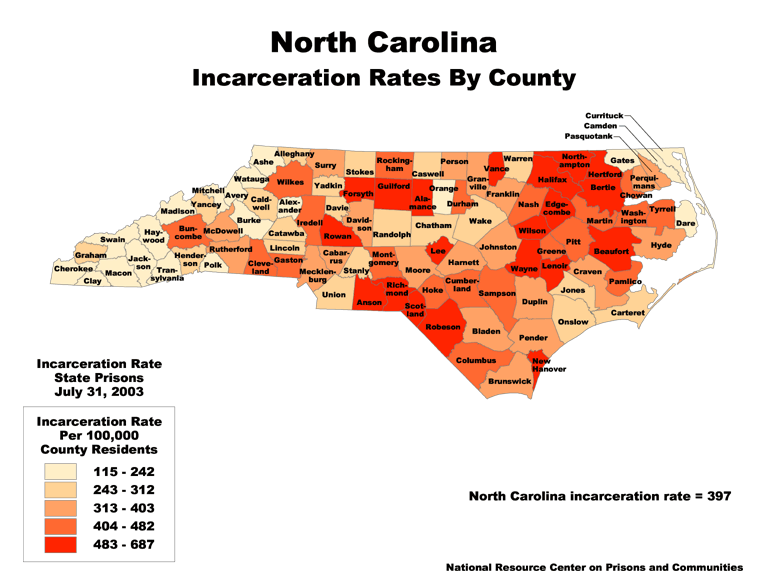
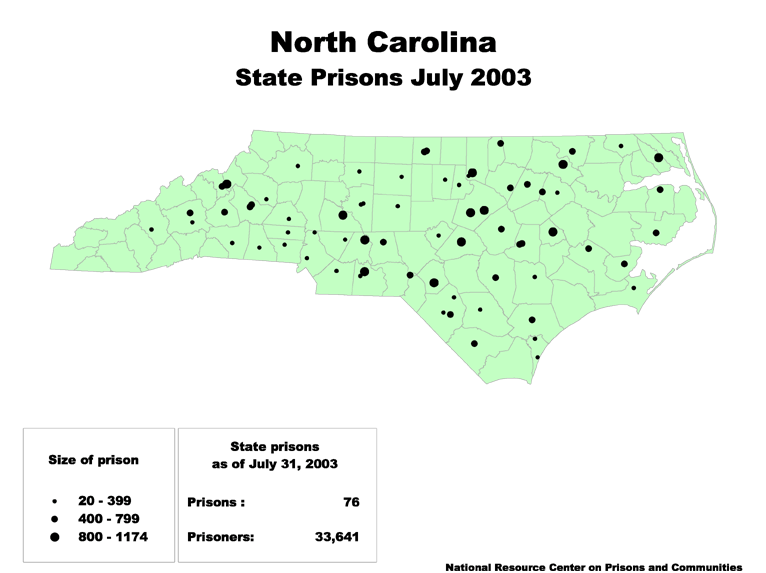
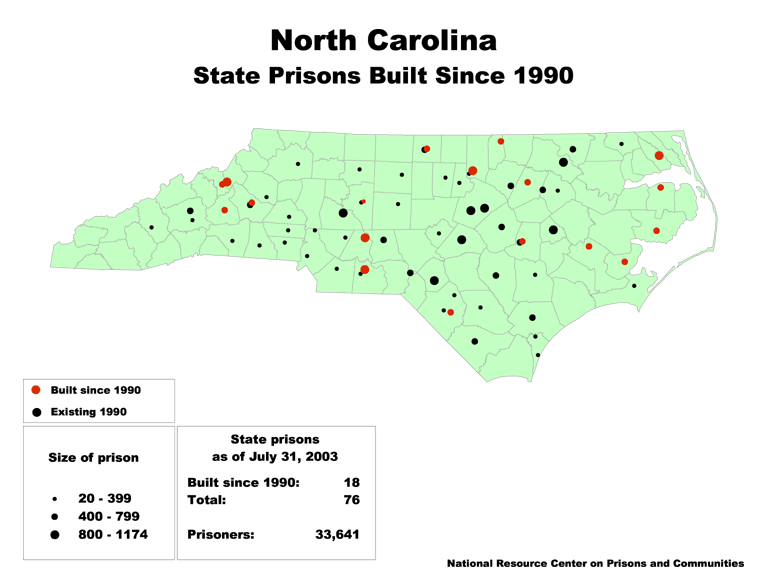
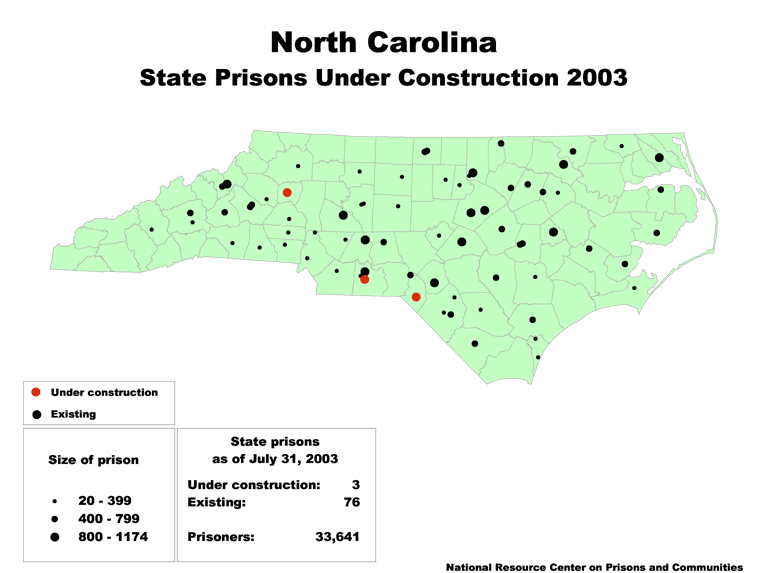
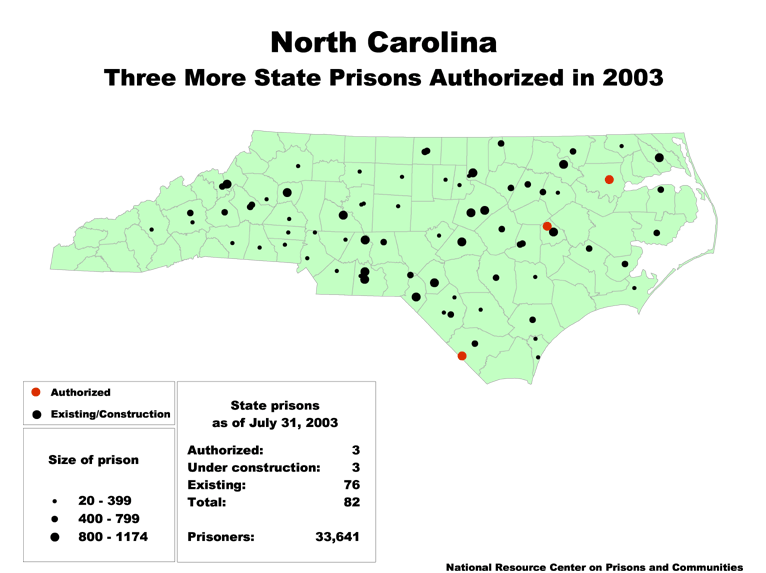

New documentary explores the historically taboo subject of homosexual relations and rape in prison.
by Peter Wagner,
July 3, 2003
New documentary: Turned Out: Sexual Assault Behind Bars
Of the over two million Americans in jail today, one out of five inmates will be sexually assaulted during their incarceration. Most of those who will be “turned out,” or sodomized, and turned into sexual slaves, will be nonviolent drug offenders who have doubled the prison population over the last decade. This video is a shocking but insightful expose of the taboo subject of homosexual rape and homosexual relations in prison. It features frank and often graphic interviews with inmates at correctional facilities throughout the U.S., in which they explain the sexual hierarchy of “iboys” or “sissies,” who play the female role to more powerful inmates known as “men,” with the latter often developing relationships with several “boys” and thus developing “families,” which provide sex, companionship and protection for more vulnerable inmates. Prisoners also discuss the underground economy, the sociology of power and lust, and the sexual exploitation of inmates by prison guards, while interviews with a prison warden and family members of inmates reveal the general awareness of sexual assault within our prison system and the culture of silence which enables its perpetuation.
It’s expensive ($295 to buy, $95 to rent), but we don’t know of anything that comes even close to this on this topic.
[Editor’s note, July 10, 2014: full film is now available here.]
The 1976 handbook to prison abolition has been digitized.
by Peter Wagner,
May 22, 2003
Instead of Prisons: A Handbook for Prison Abolitionists is now available on this website. This book summarizes the research on prisons as of the 1976 writing and discusses the strategy of abolition. For example, how do we pick reforms to fight for now that make our long term goal of abolition easier to obtain?
Thanks to everyone who helped with the digitization process!
Nil's Christie's book on the criminal justice "pain delivery system" has been digitized.
by Peter Wagner,
February 12, 2003
We can’t speak highly enough of Nils Christie’s Crime Control as Industry (review, buy from Amazon.com). Christie’s first book, Limits to Pain (1981), which argues that the criminal justice system is in fact a pain delivery system, with the size of the system controlled not by the number of committed acts labeled as crimes but by the amount of pain that a society is willing to impose on its citizens, is now available on the internet. Limits to Pain is powerful in its own right, and very helpful in studying the most recent book. We suggest you read the on-line version of Limits to Pain today.
Letter explaining why counting prison populations as residents of Coxsackie, New York undermines democracy by causing vote dilution.
by Peter Wagner,
February 3, 2003
I submitted this letter to the editor of the Daily Freeman in Greene County New York:
Dear Editor,
I agree with John Houghtaling of Athens that it’s not fair for Coxsackie to get two extra legislators because the state owns two prisons there. [Legislature remapping criticized, Daily Freeman, Jan 29, 2003].
While troubling enough in theory, the actual impact is more than twice that reported by the Daily Freeman. According to Census 2000, there are 2,870 prisoners in Coxsackie, not 1,200. Almost a third of the town’s official population is incarcerated in Coxsackie or Greene Correctional Facilities.
No more than a handful of the prisoners are from Coxsackie or Greene County, but those two prisons account for 6% of the county’s reported population. Counted in Coxsackie only as a result of a Census Bureau quirk, it’s unfair to the other portions of Greene County for Coxsackie to pretend to be 48% larger than it really is.
Using census counts of prisoners for redistricting may go beyond being “not fair” to violating the federal and state constitutions. The 14th Amendment principle of one-person-one-vote requires that legislative districts be of equal-sized populations. Including out-of-town prisoners in the count for Coxsackie gives each real Coxsackie resident greater access to county government while diluting the votes of other county residents.
The New York State Constitution is quite explicit that prisoners reside at their pre-incarceration homes and not at the prison: “no person shall be deemed to have gained or lost a residence, by reason of his presence or absence … while confined in any public prison.”
Census quirks aside, the true population of Greene County is 45,325 and Coxsackie contains 6,014 residents. While Coxsackie is really only 13.3% of the county, counting disenfranchised prisoners as Coxsackie residents swells the weight of the town to 18.4% of the county. Allowing Coxsackie to appropriate the state’s prisoners for purposes of representation at the county legislature dilutes the vote of every resident in every other town in the county.
For purposes of redistricting, counting state prisoners as Coxsackie residents is neither logical nor fair.
Peter Wagner
Prison Policy Initiative
February 3, 2003
Using incarcerated people to grant additional political clout to areas with prisons harkens back to the pernicious 3/5 clause
by Peter Wagner,
January 17, 2003
Appeared in the Winter 2002-2003 issue of Fortune News, published by the Fortune Society.
By Peter Wagner
Imagine that in some parts of the country, the local economy depends on the maintenance of a large population of working-age Blacks. Regional politicians stake their careers on keeping the number of young Blacks high, but extend the electoral franchise to no more than a handful. In one studied county, the 2,395 Blacks made up a sizable portion of the 43,424 total population, but the number of Blacks allowed to vote is just 72.
This could be a description of the Jim Crow South; but it’s not. It resembles — but it’s not — the situation after the Constitutional Convention where Southern states were allowed to keep the vote from their Black populations and yet count each Black slave as 3/5ths of a person for purposes of representation in the House of Representatives and the Electoral College.
What this does represent is the situation in Wyoming County, New York — the home of the infamous Attica Prison — “represented” by State Senator Dale Volker. Prisons are big business in his district, and Volker uses his perch on the Committee on Codes to expand over-criminalization and defend the Rockefeller Drug Laws that caused the prison boom in the first place. (Almost a third of New York State prisoners are incarcerated solely for drug offenses.)
Shoring up Volker’s political power are the 8,951 prisoners that the U.S. Census counted as rural residents of his tri-county district. Few of the prisoners are from his district, and none are allowed to vote. However, as a result of this Census quirk, the prisoners are counted as local residents for purposes of drawing legislative boundaries and attracting population-based state and federal aid.
While only 24% of New York prisoners are from the entire upstate region, over 91% of prisoners are incarcerated there. The largest portion of state prisoners (65.5%) are from New York City, so allowing the Census to count prisoners in their cells costs the city 43,740 residents. This figure represents a third of a district in the State Assembly, and dwarfs in magnitude the traditional debates about whether the inclusion of an additional neighborhood or street could tip a future election.
Like many states, New York’s constitution mandates that residence is where you choose to be and that “no person shall be deemed to have gained or lost a residence, by reason of his presence or absence … while confined in any public prison.” In 1894, New York incarcerated a man named Michael Cady for using prison as a residence in a manner measurably less offensive to the State Constitution than that the New York State Legislative Reapportionment Taskforce used to allocate residence to the state’s 71,466 prisoners.
The federal Census counts prisoners were they are incarcerated because it’s a convenient way to fulfill the Census’ only mandate: to count the number of people in each state for purposes of assigning each state the appropriate number of seats in the House of Representatives and Electoral College. But for distributing political power within a state, this methodology is inappropriate because it does not accurately reflect where a state’s population resides.
Michael Cady was a homeless man who would confess to vagrancy and get himself committed for 6 month terms to the Tombs jail. He was planning on doing so indefinitely. More than once, Cady would forget his time was up, and fail to “re-confess” to vagrancy; but the jailers would let him stay anyway. In 1894, Cady, on an occasional paid errand outside the jail, tried to register to vote using his address at the Tombs. For violating that provision of the state constitution, Cady was arrested and convicted of illegal registration. Not for registering to vote — since that was legal given Cady’s commitment was for vagrancy — but for using the Tombs address. You can not live in a prison, you must have lived somewhere else before or plan to after, successfully argued the prosecutor.
Michael Cady was far more “residential” about his imprisonment than probably all of New York’s prisoners are today, but even the voluntary prisoner Cady was not a resident of the Tombs.
According to the federal constitution’s one-person-one-vote rule, legislative districts are supposed to be equal in size to guarantee all residents equal access to government. In fact, the only deviations allowed from strict population equality are where a small deviation could avoid crossing a geographic boundary or other “community of interest”.
On a personal level, prisoners shipped upstate for incarceration “reside” there in only the most physical terms: the lives, homes and families remain in the communities the prisoners originated from, the communities that almost all prisoners will return to on the day of their release. On a political level, it is the urban minority communities ravaged by the war on drugs that have the greatest desire to see drug law reform.
Senator Volker readily admits that he doesn’t represent the prisoners in any real sense, telling Newhouse News Service that he does get letters from prisoners with a variety of complaints, but that his real attention is directed toward corrections workers, with whom he has forged strong relationships.
Transferring population out of the cities reduces the resulting number of legislators who will represent urban interests, and makes each legislator responsible for their “official” district plus those community members incarcerated elsewhere.
Senator Volker’s real constituents no doubt love the arrangement, because their issues can then receive individual attention unavailable to downstate citizens. The legislators themselves recognize how this helps them. Said Rhode Island State Representative Peter Palumbo of his own similar asset: “All these years the prison has caused me grief with my constituents. Now maybe it will help with redistricting.”
Nationally, speaking, prisons have become a growth industry for rural America, with a new prison opening in a small town every 15 days over the last decade. Now a $49 billion industry, prisons have developed the economic muscle to bend state priorities to its needs rather than the other way around. The practice of transferring the political clout of prisoners from their communities to the prison town removes the most important counter-balance to the growing economic clout of the crime control industry: the democratic power of the populace.
On this question of allowing communities to appropriate the political power of their opponents via the Census, we would be well advised to look at the impact on national history of the 3/5ths clause. Thanks to its added population, for 32 of the first 36 years of the country, the President was a slave-holder from the otherwise small state of Virginia.
Artificially boosting the political power of the South created a national stalemate that prevented the creation of a democratic solution to the slavery problem. What might have been resolved peacefully in the 1790s became the Civil War in the 1860s.
Today, a similar democratic and economic impasse presents itself in the debate over crime control policy. As the economy constricts and state budgets contract, it is absolutely essential that our political structure be responsive to changing needs of the people. A democratic catastrophe awaits if we continue to postpone answering this vital question:
How is it that the legislatures have funded prison expansion year after year when the evidence has always been clear that prisons don’t stop crime?
Peter Wagner is Assistant Director of the Prison Policy Initiative.






